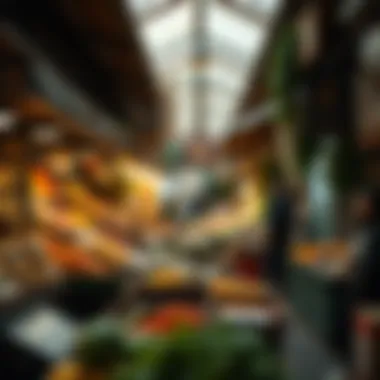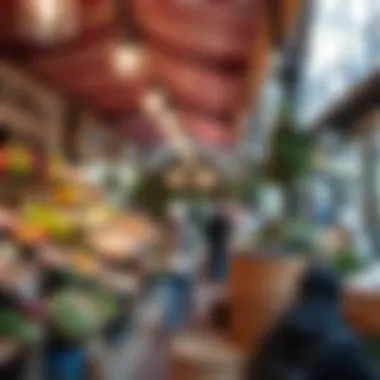Exploring the Essence of Local Markets: The سوق شعبي


Intro
The fabric of a community is often woven together through its marketplaces. One such embodiment is سوق شعبي, which translates directly to the term "popular market". These markets are not just commercial spaces; they yield a glimpse into the cultural tapestry of a locality. Here, community members engage in transactions—but they also exchange ideas, traditions, and experiences. The essence of سوق شعبي can be traced back through history, influencing social customs while also adapting to the demands of modern-day economics.
In this discussion, we will journey through the heart of these marketplaces, analyzing both their historical significance and the cultural impact they’ve made over generations. Additionally, we will explore how globalization and changing consumer behaviors have reshaped their roles in local economies. Through understanding these trends and dynamics, we aim to provide insights that cater to investors, agents, expatriates, and homeowners who are keen on immersing themselves in this fascinating aspect of local commerce.
Market Trends
Current Market Analysis
The local market landscape plays a vital role in understanding the broader economic climate. Presently, سوق شعبي are thriving, characterized by a blend of traditional and modern retail practices. Many of these markets have started integrating technology into their operations. Vendors showcase their products through online platforms, often complementing the physical shopping experience. Increasingly, platforms like Facebook and niche community forums on Reddit are becoming hotspots for cultivating community interactions.
In many urban centers, the demand for organic and locally sourced produce is on the rise. Shoppers are increasingly looking for fresh foods, unique crafts, and handmade goods, which are essential components of سوق شعبي. This shift has influenced market offerings, leading to a flourishing of artisans and small businesses who bring diverse cultural influences into their products.
"More than just a place to buy goods, these marketplaces facilitate an exchange of ideas and foster a sense of community."
Future Predictions
Looking ahead, it is evident that سوق شعبي are poised to evolve further. As urban regions expand and the preferences of consumers continue to shift towards experiential shopping, we might see a greater blend of cultural events within these markets. Potential future trends might include:
- Culinary Workshops: Where local chefs can engage with visitors, thereby promoting traditional cooking methods and regional cuisine.
- Cultural Festivals: These could celebrate local artists, crafters, and performers, turning the market space into a vibrant cultural hub.
- Sustainability Initiatives: An increase in eco-friendly products and practices, as more vendors prioritize sustainable sourcing methods.
The opportunity for growth in the realm of سوق شعبي is vast, equipping local communities with avenues for not only economic development but also cultural exchange.
Investment Insights
Best Areas for Investment
The prospect of investing in سوق شعبي can offer lucrative returns, especially in areas ripe with cultural significance and modern population growth. Emerging neighborhoods often present the best opportunities for investors. Key areas include:
- Central Business Districts: These locations benefit from high foot traffic and tourist attractions.
- Art Districts: Areas packed with galleries and performance spaces, which can enhance the artistic vibe of سوق شعبي.
- Gentrifying Neighborhoods: As these areas undergo revitalization, they can become hotspots for new businesses and diverse markets.
Tips for First-Time Investors
For those new to the investment game, some fundamental tips can help navigate the intricacies of سوق شعبي investments:
- Do Your Homework: Understanding the local market dynamics and community sentiments is crucial.
- Engage with Community Members: Building relationships with vendors and customers can provide valuable insights.
- Consider Partnership Opportunities: Teaming up with local business owners might help mitigate risks and expand influence.
- Seek Guidance from Experts: Consulting with real estate agents or local economic development authorities can enhance decision-making.
By paying close attention to the سوق شعبي landscape and engaging with community cultures, investors can strike a chord with local markets that are both economically viable and culturally enriching.
Understanding السوق الشعبي
In the realm of local commerce, السوق الشعبي functions as more than just a marketplace; it’s a mirror reflecting community identity and cultural values. Understanding this concept is crucial, as it encapsulates the essence of how local residents interact, how they maintain traditions, and how economic activities unfold. By delving into this topic, one can appreciate the intricate threads that connect commerce with community life.
Defining the Concept
At its core, السوق الشعبي symbolizes the convergence of local goods, services, and social interactions. It's not merely a shopping space; it acts like the heart of the community, fueling economic activities and fostering relationships. People gather here not only to buy and sell but to engage in a collective experience steeped in cultural significance. Markets are bursting with colors, sounds, and smells that embody local tastes and preferences. They serve as a vibrant backdrop for daily life, illustrating the unique characteristics of the area.
Historical Background
The Origins of Traditional Markets
To grasp the significance of السوق الشعبي, one must look back at its origins. Traditional markets have been around for centuries, integral to ancient trade routes, where diverse cultures met and exchanged goods. This historical tapestry has led to the establishment of markets as vital social hubs, where not only transactions occur but also cultural exchanges flourish. A key characteristic of these origins is their ability to adapt and incorporate diverse influences, making them a rich blend of various customs. This adaptability is beneficial for understanding how local markets serve their communities today. With their historical roots, السوق الشعبي can maintain a nostalgic charm while continuing to evolve.
The Evolution of Market Spaces
As societies progressed, so did the design and function of marketplace spaces. The evolution of السوق الشعبي reflects broader changes in economy and urbanization. Modern technology and shifting demographics have transformed these markets from traditional barter systems to more structured economic entities. This evolution showcases a blend of old and new, where digital payments coexist with cash transactions. While the convenience of modernity is definitely an advantage, it sometimes overshadows the authenticity that makes السوق الشعبي appealing. Understanding how these spaces have transformed offers insight into current challenges and opportunities facing local commerce.
Significance in Local Culture
Cultural Identity and Community
The role of السوق الشعبي in shaping cultural identity cannot be overstated. It’s often regarded as the lifeblood of local culture, reflecting the unique characteristics of a community. Each market is a microcosm of its surroundings, displaying everything from traditional music to local crafts. This strong association with cultural identity makes it a vital choice for exploring the dynamics of the local community. The distinctiveness of each السوق الشعبي fosters a sense of belonging among residents, creating a network of social support that enriches community life. As cultural markers, these markets help preserve historical artifacts and practices that might otherwise fade away.
Traditions and Practices
Traditions associated with السوق الشعبي are as varied as the goods sold within its spaces. Seasonal celebrations, festivals, and local customs all find expression in the marketplace. These events serve to strengthen community bonds and enhance cultural pride. A unique feature of such traditions is their ability to draw in visitors, both domestic and international, thereby acting as avenues for cultural exchange. They offer a way for local people to showcase their heritage, while also introducing their culture to outsiders. However, this brings challenges; as markets modernize, there's a risk that some traditional practices may be overshadowed or lost altogether, which is a crucial consideration in the ongoing dialogue about the future of السوق الشعبي.


The Structure of السوق الشعبي
Understanding the structure of سوق شعبي is crucial since it provides insights into how these markets function, flourish, and serve their communities. The physical layout, design, and the variety of offerings play significant roles in enhancing the shopping experience, fostering social interaction, and ultimately contributing to the local economy.
Physical Layout and Design
Types of Vendors
The types of vendors in a سوق شعبي are not just varied; they embody the essence of the marketplace itself. From local farmers selling fresh produce to artisans showcasing handmade goods, the diversity is astounding. Each vendor brings a unique flair, contributing to a rich tapestry of cultural expression. For example, you might find a stall with spices stacked high, their aromas mingling in the air, right next to a vendor selling traditional sweets that are made from family recipes passed down through generations.
This eclectic mix is significant because it attracts a broad spectrum of visitors. Each group may have different motivations for coming, be it the quest for the freshest vegetables or an interest in handmade crafts. This diversity also allows the market to evolve and adapt, catering to the needs of the community while preserving its traditions. However, challenges may arise, such as competition between vendors, which can drive prices down or cause tensions if not managed properly.
Spatial Organization
Spatial organization in a سوق شعبي is another cornerstone of its structure. The arrangements are often organic and can evolve over time as vendors establish loyalty among customers. A well-laid-out market can facilitate efficient movement, making it easier for shoppers to navigate. For instance, there might be designated areas for perishable goods like fruits and vegetables, separated from sections for handicrafts and textiles.
This intuitive layout is not just practical; it enhances customer experience—visitors can quickly find what they’re looking for without circling the entire market. Additionally, spatial organization often reflects the cultural priorities of the community, with some areas paved for gatherings and events, showing that market life extends beyond mere commerce into social gatherings.
Variety of Offerings
Local Cuisine
Local cuisine is one of the vibrant elements of the سوق شعبي. Food vendors not only provide nourishment but also open a window into the cultural heritage of the region. Imagine bustling stalls where you can get everything from spiced lentil soup to grilled skewers, all while engaging in conversation with passionate cooks who often share their secrets with the eager customers. The sensory experience here is palpable; the colors, smells, and tastes combine to create an inviting atmosphere.
Ultimately, local cuisine attracts both locals and tourists, serving as a culinary showcase that fosters appreciation for traditional fare. While this is a boon for business, there are downsides—sometimes, locations can serve food that doesn’t meet health regulations, posing risks for both vendors and customers.
Handicrafts and Artisanal Goods
Handicrafts and artisanal goods hold a special place in the heart of the سوق شعبي. Stalls brimming with handwoven textiles, intricately carved wooden items, and ceramics tell stories of their makers. Each item usually comes with an artisan’s touch, which adds not just value, but also a narrative that connects buyers to the local culture. This connection is often why people prefer to buy handmade goods over mass-produced alternatives.
However, while these unique products offer distinct advantages, they can also have drawbacks. The skill involved means that these items may be priced higher than machine-made counterparts, which might deter some potential customers. Yet, for those who seek authenticity and want to support local artisans, these goods represent much more than mere transactions—they embody sustainable practices and a sense of community.
"In a world of mass production, handicrafts serve as a reminder of human creativity, skill, and cultural heritage."
Addressing both the benefits and challenges associated with the structure of السوق الشعبي provides a comprehensive view of its function and significance within the local community.
Economic Aspects of السوق الشعبي
The economic aspects of سوق شعبي play a pivotal role in understanding its value to both the community and the broader economy. Traditional markets like these serve not only as places for commerce but also as significant cultural and social hubs. In this section, we will discuss the nuances of local markets, including their interactions with global systems, their contributions to job creation, and their support for small businesses.
Local vs. Global Markets
Understanding the dynamic interplay between local and global markets is essential. Local markets face unique challenges when competing against larger, multinational entities. This competition often forces smaller vendors to adapt quickly, sometimes leading to a loss of traditional practices or products.
Challenges in Competition
The challenges in competition reflect a critical reality for بازار شعبي operators. They often find themselves pitted against online giants or large retail chains that can offer goods at lower prices due to economies of scale. While the community focus and traditional offerings are appealing, vendors have to wrestle with the fact that consumers may opt for convenience over quality.
These challenges can compel market owners to innovate and offer unique products that larger stores cannot match. Such a struggle can catalyze creativity—think of artisanal goods crafted with local materials that tell a story in every purchase. However, there can also be downsides. If local vendors can’t keep up with these commercial pressures, it might lead to a decline in the market’s vibrancy.
Adapting to Global Trends
To survive in this ever-evolving landscape, adapting to global trends becomes a necessity. This means local vendors may need to incorporate modern payment systems, engage with digital platforms for marketing, and even consider food delivery services. By doing so, they remain relevant in a digital-first economy.
Such adaptability not only attracts a younger demographic but revitalizes the market overall. Vendors become more versatile, catering to consumer preferences that vary widely. However, it also raises questions about authenticity and sustainability. How much change can a market withstand before losing its unique identity? Striking this balance is crucial.
Impact on Local Economy
The impact of سوق شعبي on the local economy cannot be overstated. It is a linchpin in job creation and offers invaluable support to small businesses. Here, we will delve further into these two aspects.
Job Creation
Job creation is undoubtedly one of the most apparent benefits of such marketplaces. They provide employment opportunities not just through direct sales, but indirectly through associated services like food preparation and logistics. In bustling city centers or rural towns, these markets can be a mainstay for local employment.
The symbiotic relationship between the market and the community fosters a sense of belonging and stability for many families. Yet, precarious job security in such sectors can lead to challenges. Many vendors operate on tight margins, making it difficult to offer full-time employment or benefits.
Support for Local Businesses


Equally important is how سوق شعبي serves as a guardian for local businesses. By purchasing from neighborhood vendors, residents keep their money circulating within the community. This can lead to a richer tapestry of local goods and services that reflect the area’s cultural identity.
A unique feature of market support comes from local collaborations and partnerships among vendors, which can amplify their collective buying power and marketing efforts. Through community initiatives, small businesses can showcase their strengths while mitigating risks associated with competition. However, the challenge remains how to sustain this bond when facing pressures from larger corporations trying to capture the same market share.
In summary, the economic facets of سوق شعبي underscore its ongoing relevance in both local and broader contexts. Balancing competition, job creation, and direct support for small businesses is essential for maintaining this cultural touchstone.
Overall, when understanding the essence of سوق شعبي, it's crucial to appreciate its economic contributions and the unique landscape it occupies, reflecting local needs while grappling with global influences.
Social Interactions Within السوق الشعبي
Understanding the layers of social dynamics within the سوق شعبي is pivotal to appreciating its place in local life. These markets are more than just shopping destinations; they are communal spaces where relationships are nurtured and cultural exchanges unfold. The ebb and flow of interactions among vendors, customers, and community members enrich the market's vibrancy, making it a living tapestry of social engagement.
Building Community Connections
Social Networks
Social networks formed around سوق شعبي often serve as the backbone of local interactions. These are not just informal groups; they foster a sense of belonging and solidarity. For instance, relationships between merchants and regular customers oftentimes blossom into friendships. A unique characteristic of these connections is their ability to transcend mere transactional relationships. This is, in many ways, what makes the سوق شعبي a popular choice for those seeking a more personal shopping experience.
The beauty of social networks lies in their organic growth, wherein individuals share stories, cultural nuances, and even familial ties that enhance the authenticity of the market. However, relying solely on these networks can create insular communities that may miss out on broader economic opportunities.
Intergenerational Relationships
Intergenerational relationships within the سوق شعبي reveal another dimension to community interactions. Elderly vendors often mentor young entrepreneurs, passing down not just business acumen but also traditions and values that ground the culture. This interplay is critical as it sustains the deep roots of local identity and ensures continuity of cultural practices.
You might find, for instance, that the elderly often share stories of how the marketplace has evolved, infusing younger generations with a sense of purpose and history. The key characteristic here is mutual respect. This system of sharing knowledge can be incredibly beneficial for both parties, despite the challenges sometimes posed by generational differences.
Events and Gatherings
Festivals at Local Markets
Festivals held within سوق شعبي act as catalysts for social interaction and cultural enrichment. These events create an atmosphere of celebration, fostering unity within the community. One notable aspect of such festivals is that they often incorporate local traditions, arts, and cuisine, drawing in visitors from outside the neighborhood. This not only boosts economic activity but also heightens cultural awareness.
However, while festivals bring joy and connection, they can also stretch the resources of the market and disrupt daily business operations. Balancing the festival spirit with the market’s day-to-day activities can be a challenge for vendors and organizers alike.
Seasonal Celebrations
Seasonal celebrations follow a similar rhythm to festivals, bringing a fresh air of excitement and connection among people. These events mark important occasions and often reflect the agricultural calendar, showcasing seasonal produce and confections unique to local traditions. They invite community members to come together and partake in rituals that reinforce cultural heritage.
The advantages of these celebrations are multifaceted. They allow local artisans and farmers to exhibit their goods, while offering customers a chance to engage more deeply with their cultural roots. However, the challenge lies in adapting these celebrations to modern tastes without losing their authenticity. The quest to keep traditions alive amidst the changing times can be a delicate balance and an ongoing conversation within the community.
Challenges Facing السوق الشعبي Today
The traditional markets, or سوق شعبي, have served as integral parts of community life, bringing people together to share not just products but also stories and cultures. However, these markets are now facing a multitude of hurdles that threaten their very existence. It is crucial to understand these challenges as they illuminate the changing dynamics within local economies.
Urbanization and Market Decline
The rapid pace of urbanization has become a double-edged sword for سوق شعبي. On one hand, urban growth creates opportunities for local shops and vendors. On the other, it leads to a decline in traditional market spaces. Many local markets are getting pushed to the outskirts as modern shopping malls and business complexes come into play. This growing trend turns vibrant neighborhoods into ghost towns, every building replaced with concrete slabs that diminish community spirit.
When families move into new urban developments, the character of the neighborhood shifts. Marketplaces, once alive with chatter and trade, start to lose foot traffic. This exodus of locals reduces sales for vendors, ultimately leading to market decline. Local markets must innovate or risk becoming obsolete. For instance, integrating online platforms for hybrid shopping experiences might keep them relevant amid changing shopping habits.
Regulatory Issues
Licensing and Compliance
An essential aspect of operating within the market is adhering to local regulations related to licensing and compliance. Many vendors struggle to navigate the bureaucratic maze, posing a significant barrier to entry. For smaller businesses, the costs associated with getting all the necessary permits can be overwhelming. Not only are there fees, but the time taken to sort through paperwork can lead to lost earnings.
The characteristic of licensing emphasizes transparency, bringing a level of trust between the vendors and consumers; it ensures that the products being sold meet safety and quality standards. However, heavy-handed regulations can stifle creativity and limit the diverse offerings that سوق شعبي usually brings.
Unique challenges arise when vendors cannot secure the required licenses. They find themselves operating in the shadows or out of compliance, risking fines or closures. This ultimately creates a less vibrant market with fewer options for consumers.
Environmental Concerns
Environmental concerns add another layer of complexity to the struggles facing سوق شعبي. Issues like waste management, pollution, and resource sustainability are becoming increasingly important. Many traditional markets lack the infrastructure to deal with these problems. For instance, vendors selling food have to grapple with waste disposal—a crucial aspect of maintaining an inviting atmosphere.
The nature of environmental concerns brings awareness to the broader community about the importance of sustainability. There's a push for vendors to adopt eco-friendly practices, such as reducing plastic usage and encouraging recycling. However, the initial investment in greener practices can be steep, and small vendors may hesitate if it threatens their profit margins.
Ultimately, the struggle between maintaining traditional values and adapting to new environmental standards poses ongoing challenges for local markets. They must find a balance that allows them to preserve cultural traditions while also embracing a future that demands responsibility to the planet.


"Urbanization and environmental issues are like a rollercoaster ride. While they bring new opportunities, they come with unexpected twists that can derail our faithful سوق شعبي."
In summary, navigating complexities such as urbanization, regulatory frameworks, and environmental responsibilities is crucial for سوق شعبي to thrive in today's ever-evolving landscape. Future-proofing these markets by adapting to these challenges will not only preserve their essence but also ensure that they continue serving as vibrant community touchstones.
The Role of Technology in Transforming السوق الشعبي
In today’s fast-paced world, technology has a significant part to play in reshaping traditional marketplaces, including the سوق شعبي. As these bazaars evolve, technology provides not just a lifeline, but a roadmap for enhancing their relevance and usability in contemporary society. The integration of tech into these marketplaces reflects broader shifts in consumer behavior and expectations, and understanding these changes is crucial for all stakeholders involved.
E-Commerce Integration
Online Shopping Platforms
Online shopping platforms have come to symbolize modern retail, bridging the gap between the local market atmosphere and global reach. These platforms are pivotal in bringing a wider audience to the unique offerings of a سوق شعبي, often allowing vendors to reach customers who may not be able to visit in person. A distinctive aspect of these platforms is their ability to showcase local products through beautiful, user-friendly interfaces.
The ease of navigation and seamless transaction processes make online shopping appealing for consumers seeking convenience. Moreover, it enables traditional vendors to maintain their cultural identity while adapting to new sales tactics. However, the big downside could be loss of personal interaction characteristic of physical markets, where stories and relationships are woven into the fabric of buying and selling.
"The future of traditional markets lies in their ability to adapt to the digital age, preserving cultural essence while embracing modern convenience."
Virtual Market Experiences
Virtual market experiences leverage technology to create an immersive atmosphere for shoppers unable to visit their local سوق شعبي physically. By utilizing virtual reality and augmented reality, market organizers can recreate the essence of market visits, allowing people to 'wander' through stalls and interact with vendors from the comfort of their homes. This characteristic is particularly powerful when it comes to showcasing intricate handicrafts that are best appreciated up close.
While such experiences can draw in a broader audience, a notable drawback is that they might lack the sensory richness—the sounds, smells, and tactile experiences that define a physical سوق. Nevertheless, the convenience and novelty of these virtual options can boost interest and consumer engagement, allowing vendors to innovate their sales techniques.
Digital Payment Solutions
Mobile Payments
Mobile payment solutions are reshaping how transactions are made in سوق شعبي. They enable a swift exchange of goods for cashless transactions, which today’s consumers are increasingly favoring. This convenience is crucial, particularly in regions where cash transactions may pose a challenge or risk. With platforms like PayPal or digital wallets, both vendors and customers enjoy a smoother point-of-sale experience.
A key distinguishing feature is the immediacy of these transactions, as mobile payments can be processed instantaneously, enhancing customer satisfaction. However, on the flip side, there can be some skepticism among older generations who are still getting accustomed to digital financial practices. Despite this, mobile payments are proving advantageous as they encourage quicker transactions and better tracking of financial activities.
Impact on Consumer Behavior
The integration of technology, particularly digital payment solutions, has transformed consumer behavior in profound ways. As shoppers find convenience in online purchases and mobile usage, their spending habits shift towards platforms that offer these innovations. They are now more likely to prioritize ease and speed over traditional shopping experiences.
One unique characteristic is the tendency for impulse buying to increase in environments where mobile payments are readily available. This shift can be a double-edged sword: while it can increase vendor sales, it may encourage consumers to spend more than intended. Nonetheless, understanding this behavioral change is essential, as it offers insights into adjusting marketing strategies and inventory management to align with new consumer mindsets.
By examining how technology transforms the traditional سوق شعبي, one can discern a path to navigating the future landscape of local markets. It holds promise for preserving culture while fostering economic vitality through modern methods.
The Future of السوق الشعبي
As we look ahead towards the future of السوق الشعبي, it's imperative to recognize its enduring significance amidst the waves of change brought by modernization and globalization. The traditional marketplace, with its rich tapestry of history and culture, is facing numerous challenges yet also ripe with opportunities for transformation. It acts as a focal point not only for economic activities but also as a cultural hub that fosters community identity.
Cultural Preservation Efforts
Community Initiatives
One of the vital components of preserving the essence of سوق شعبي is through community initiatives. These grassroots movements empower local vendors and artisans, ensuring that traditional crafts and culinary practices do not fade into oblivion. A key characteristic of these efforts is the active involvement of the local populace, who are passionate about maintaining their heritage. For instance, workshops that teach traditional cooking methods or craft-making are becoming increasingly popular. These initiatives foster a sense of belonging and pride, as community members share their skills with the younger generation.
However, while these initiatives have many advantages—such as strengthening community bonds and preserving cultural identity—they also face disadvantages. Funding can be scarce, and interest among youth might wane as they pursue modern careers. Regardless, community initiatives are a beneficial choice for future developments in the marketplace, helping keep its heart alive.
Support from Authorities
Support from regulatory and governmental bodies plays a crucial role in the future of سوق شعبي. Authorities can provide crucial backing through grants, marketing support, and infrastructure improvements. A key characteristic of such support is the recognition that a healthy local market is an asset to the community and contributes to overall economic stability. For instance, initiatives that promote local festivals help bring attention to the market, drawing in both locals and tourists.
That said, the relationship between local vendors and authorities can be complex. While some policies may positively affect marketplace operations, they can also impose restrictions that limit creativity or flexibility for vendors. Overall, while there are drawbacks, the potential for positive impact makes support from authorities indispensable for the future viability of these markets.
Adapting to Change
Innovations in Traditional Commerce
Adapting to the changing economic landscape through innovations in traditional commerce is essential for سوق شعبي's future. These innovations might creep in through the implementation of new technologies such as digital inventory systems that help vendors manage stock effectively. A defining feature of these innovations is their ability to streamline operations, helping local businesses compete more effectively with larger, global brands.
The introduction of e-commerce platforms allows vendors to reach a broader audience without being limited by geographic boundaries. The flip side is that adaptation requires investment—both in time and money—and not every small vendor may have the resources to stay competitive. However, those that embrace these changes will likely see enhanced sustainability and longevity in their marketplace endeavors.
Sustainability Practices
Sustainability practices are becoming a core focus for the future of the local market. Concerns over environmental degradation and climate change have pushed markets to adopt methods that reduce waste and promote eco-friendly products. One of the critical characteristics of these practices is the emphasis on sourcing locally and reducing carbon footprints.
Utilizing biodegradable packaging or implementing recycling programs are a couple of ways markets are becoming greener. Such practices not only cater to the growing consumer demand for responsible options but also enhance the market's appeal, drawing in environmentally conscious customers. However, the transition may pose challenges, especially for smaller vendors who may find it difficult to bear the costs associated with sustainable practices. The balance of sustainability with economic viability will be pivotal in shaping the future of السوق الشعبي.
In essence, the future of السوق الشعبي hinges on a blend of cultural heritage, active community involvement, and strategic adaptation to modern demands. By prioritizing these factors, the market can not only survive but thrive.
Overall, while العرق is rich with tradition, strategic foresight into these aspects will determine its evolution. By recognizing the vital importance of community efforts, governmental support, and modern adaptations, the essence of the local market can continue to flourish for years to come.











